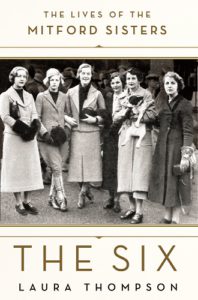by Laura Thompson
Take six girls, all of them rampant individualists, and let them loose upon one of the most politically explosive periods in history. This is the story of the Mitford sisters. It is like a social experiment, the results of which would have staggered even the most imaginative scientist, and no small part of its fascination lies in the fact that the experiment can never be repeated. Never again will there be six such girls, raised in such a way, at such a time.

The Mitford sisters were born in the heart of England, between 1904 and 1920, into a family of pre-Conquest antiquity. Daughters of the 2nd Lord and Lady Redesdale, they were expected to become wives, mothers, propagators of their class, the kind of women who appeared at state balls in slightly ill-fitting satin and tramped through Gloucestershire in good tweed. Something of this steadfast upbringing always remained with them: Nancy Mitford confessed on her deathbed that she would give anything for one more day’s hunting. But a world beyond the Heythrop had long since claimed Nancy, and indeed all the girls except Pamela – the shadowy exception – who threw the rest into even more powerful light.
Who were the Mitford sisters?
One can chant the careers of the Mitford sisters in the manner of Henry VIII’s wives, thus: Writer; Countrywoman; Fascist; Nazi; Communist; Duchess. One can recite the mini-biographies, pulling out extraordinary facts with the practiced ease of a conjurer.
Nancy
An auto-didact who never learned to punctuate (Evelyn Waugh: ‘it is not your subject’), became a star author whose 1940s novels The Pursuit of Love and Love in a Cold Climate are deeply loved popular classics.
Pamela
The bucolic chicken-breeder whose blue eyes matched her Rayburn, was adored by the young John Betjeman (‘Gentle Pamela, most rural of them all’).
Diana
The greatest beauty of her generation, calmly put herself beyond the social pale when she left her perfect husband for the leader of the British Union of Fascists, Sir Oswald Mosley.
Unity
Unity, conceived in a Canadian town called Swastika, became a fervent Nazi and the close companion of Adolf Hitler.
Read more about Unity Mitford and her secret love affair with Adolf Hitler here

Jessica
Eloped with her fellow Communist, Esmond Romilly, the nephew (and rumored son) of Winston Churchill, and proudly set up home among the working classes of Rotherhithe.
Deborah
Became chatelaine of Chatsworth House, the magnificent seventeenth-century seat of the Devonshire family, where she filled her office with Elvis Presley memorabilia.
All this poured out in a great torrent of newsprint when Deborah – ‘the Last Mitford Girl’ – died in 2014, although the facts were already familiar. Some people may have thought that Nancy was the Fascist and Unity the Communist, but they pretty much had the basic idea. Equally familiar was the collective aspect of the sisters: their irrepressible aristocratic levity, their variations-on-a-theme faces, their idiom. The Mitford sisters inhabited a linguistic micro-climate, whose almost nursery way of speech (‘oh do be sorry for me’) is famous above all for the nicknames they gave to everybody, especially to each other, which began as a private joke and were later displayed for public consumption.
Again, people may have sometimes got things confused and thought that Woman was the Nazi and Honks the Writer, or that Stubby was the Countrywoman and Bobo the Duchess; nevertheless there was an awareness that this was how the Mitford sisters went on. They all met Hitler and they all called him Hitty or Herr House-painter. Or something like that.
LAURA THOMPSON is a writer and freelance journalist. She won the Somerset Maugham award for her first book,The Dogs, and is also the author of the critically acclaimed biography of Nancy Mitford, Life in a Cold Climate, Agatha Christie: An English Mystery (2007) and A Different Class of Murder: the Story of Lord Lucan (2014). She is the author of THE SIX: The Lives of the Mitford Sisters.

